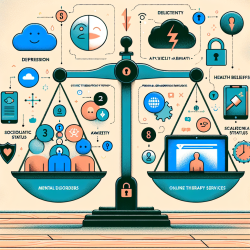Introduction
In the ever-evolving landscape of healthcare, practitioners are continually seeking innovative strategies to enhance patient outcomes. The research article "Health Information Exchange: A Novel Re-linkage Intervention in an Urban Health System" presents a compelling case for leveraging Health Information Exchanges (HIEs) to improve the linkage and retention of out-of-care patients with HIV. This blog explores the key findings of the study and offers insights into how practitioners can integrate these strategies into their practice to enhance patient care.
Understanding the Study
The study conducted a retrospective cohort analysis of out-of-care people with HIV (PWH) who generated an HIE alert in the Grady Health System Emergency Department. The intervention involved a social worker-led re-linkage effort triggered by HIE alerts, which identified patients who had not undergone specific tests in the prior 14 months. The primary outcomes measured were linkage to care and viral suppression within three to six months.
Key Findings
- Patients receiving the HIE-informed social worker intervention were 63% more likely to link to care within six months compared to those who did not receive the intervention.
- The intervention showed potential in increasing the likelihood of achieving viral suppression, although further research is needed to confirm this outcome.
- The study highlights the importance of integrating HIEs with social worker interventions to systematically identify and engage out-of-care PWH.
Implementing HIE Strategies in Practice
For practitioners looking to improve patient engagement and outcomes, the integration of HIEs can be a game-changer. Here are some steps to consider:
- Collaborate with Social Workers: Establish partnerships with social workers trained in motivational interviewing to provide personalized support and address barriers to care.
- Utilize HIE Alerts: Leverage HIE alerts to identify patients who are out of care and in need of re-engagement. This proactive approach can help bridge gaps in care.
- Enhance Communication: Use the data from HIEs to facilitate communication between healthcare providers and patients, ensuring that critical information is shared in real-time.
- Focus on Continuity of Care: Implement strategies that not only link patients to care but also ensure their retention and engagement over time.
Encouraging Further Research
While the study provides valuable insights, it also underscores the need for further research to validate and expand upon these findings. Practitioners are encouraged to participate in or initiate studies that explore the impact of HIEs in different settings and with diverse patient populations. By contributing to the body of research, practitioners can help refine these interventions and optimize patient outcomes.
Conclusion
The integration of Health Information Exchanges with social worker-led interventions offers a promising avenue for improving the care continuum for out-of-care patients with HIV. By adopting these strategies, practitioners can play a pivotal role in enhancing patient engagement, achieving viral suppression, and ultimately improving health outcomes. To delve deeper into the research, practitioners can access the original study: Health Information Exchange: A Novel Re-linkage Intervention in an Urban Health System.










